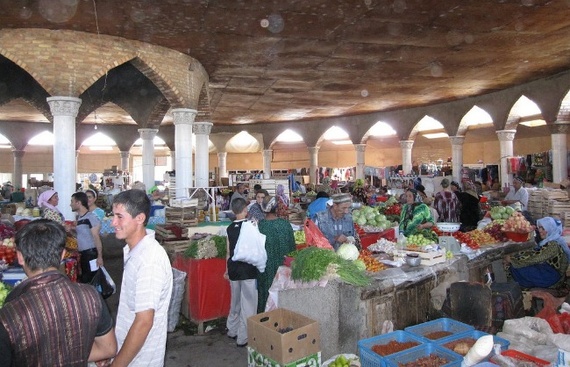
Alexandros Petersen, December 02, 2013
Outside Kyrgyzstan’s capital, Bishkek, lie two major transit hubs. To the west is the Manas Transit Center, the United States’ main waypoint for soldiers coming in and out of Afghanistan. And to the north is the Dordoi bazaar, said to be the largest re-export market in Central Asia, a funnel for cheap Chinese goods to the relatively rich consumers of Kazakhstan and Russia. The Manas Transit Center is set to close in 2014, marking the end of Washington’s major security presence in the region. Dordoi, meanwhile, will be open indefinitely, an enduring symbol of the region’s Chinese-dominated future.
With more than ten thousand traders packed into endless rows of shipping containers, Dordoi has the chaotic feel of an ancient Silk Road bazaar. Central Asia’s various ethnic groups—including the Kyrgyz, Kazakhs, Turks, Russians, Uzbeks, Tajiks, Uighurs, and Iranians—are present here, distinguished by their dress, language, and physiognomy. But the group that stands out most is the Chinese, a group that, in spite of racism and harassment from locals, continue to arrive, their trading networks behind them. For the Chinese, this is the promised land: a place with little government oversight where they can make money hand over fist.
The Chinese presence is disruptive. Han traders from the coast have connections to manufacturers (often family members) essential for ensuring the best price margins, while the Hui (Chinese Muslims) control much of the truck transport network overland from western China into Kyrgyzstan. The latter arrangement has caused tension with local Kyrgyz, resulting in violent clashes at the Kyrgyzstan-China border. Han businessmen, meanwhile, who often speak little Kyrgyz or Russian and stick to themselves, experience muggings, extortion and sometimes targeted killings.
But despite these problems, Kyrgyzstan, a WTO member, remains the main entry point for Chinese goods, and over the past decade and a half Chinese businessmen have penetrated into almost every sector of Kyrgyzstan’s economy. They are generally not worried about Russia’s plans to develop a protectionist customs union for the region, one including Kyrgyzstan and Kazakhstan and aimed mainly at hiking up tariffs on Chinese goods, because in practice, Russia’s economy presents no competition.
It is these activities—multifarious, undirected, and individual—that have brought Central Asia into China’s economic orbit. Consider the Han cook whose dumplings, sold from a makeshift cart in the Dordoi bazaar, I recently had for lunch. As I ate, he decanted noodle soup into the bowls of Chinese vendors while simultaneously taking orders on the phone from customers across the bazaar. Had the man come here as a trader and then realized that the food business was more lucrative? No, he and his wife were cooks in Nanjing and relocated here to make more money. After all, the thousands of Chinese traders here have to eat—and they prefer food from home.
Similar stories abound throughout Central Asia’s great marketplaces. At the Barakolka bazaar outside of Kazakhstan’s largest city, Almaty, a hyperactive stall owner from Xi’an played one of the Silk Road’s oldest roles: carpet seller. But his wares were synthetic, mass-produced versions of traditional Kazakh, Kyrgyz and Turkmen patterns, which have quickly displaced the intricate, hand-made wool and silk versions that once dominated. At the smaller, “Shanghai” bazaar in Dushanbe, Tajikistan’s capital, a purveyor of Chinese furniture complained that his business was less lucrative than that of his countrymen operating in Kyrgyzstan. He hoped that investment from China’s energy giant China National Petroleum Corpoation (CNPC) in Tajikistan’s oil and gas fields would eventually trickle down to his customers.
Back in Bishkek, in a more “high-end” Chinese department store, another furniture salesmen spoke about when, in the 1990s, local thugs stole over a hundred thousand dollars from him. He nonetheless stayed in country, and in fluent Kyrgyz, he conducts business with associates over the phone. After having—according to him—gained and lost several fortunes, he viewed his current enterprise as a quiet retirement gig. Central Asia was indeed a land of opportunity and, despite the risks, he said, it was more comfortable and safe than Chinese cities.
According to some estimates, up to 70 percent of migrants into Kyrgyzstan are Han Chinese, and Chinese billboards, restaurants, construction projects and language classes are everywhere in the region’s cities. When I ask Kyrgyz, Kazakhs, Uzbeks or Tajiks in the region what they think about the Chinese people, the responses are often aggressive and ugly, reflecting classic “yellow peril” fears. But when I ask the same Central Asians with whom they would like to do business, the answer is uniform: the Chinese. And like the Chinese, these young Kryrgyz and Uzbeks want to travel to Urumqi and Guangzhou to bring products to sell all over the region. China has Central Asia by the pocketbook, and it shows no sign of letting go.
